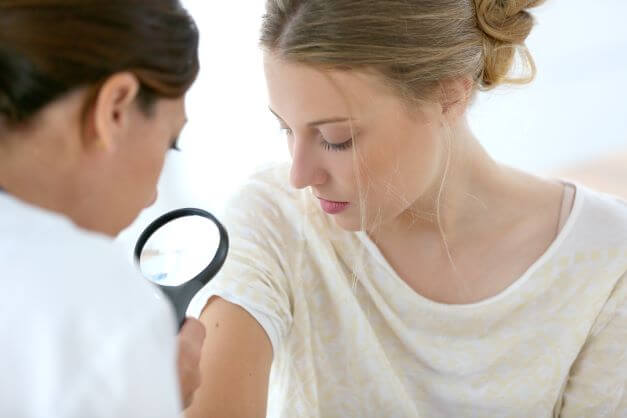While there are many different types of skin cancer, melanoma may be the most dangerous when it comes to skin health and overall well-being. According to Dr. Nicholas Golda of U.S. Dermatology Partners in Lee’s Summit, Missouri, “Melanoma has a well-earned reputation for being deadly, so it can be scary if you are concerned you may have a melanoma, but there is good news. With appropriate preventive measures, you can significantly reduce your risk for melanoma. If caught in the early stages, melanoma is often treatable, so it’s important to contact a dermatologist immediately if you are concerned that you have a spot that may be a melanoma.” In this blog, Dr. Golda will go through the melanoma basics, including what it is, common causes, prevention methods, treatment options, and more.
What Is Melanoma?
Melanoma, according to Dr. Golda, is the most dangerous of the common forms of skin cancer. In the United States, nearly 200,000 people will be diagnosed with melanoma this year. There are several different types of melanoma, including melanoma that does not make pigment, which is referred to as amelanotic melanoma. Some melanomas begin with a superficial variant known as melanoma in situ, while others begin as an invasive melanoma. Because melanoma can present in so many different ways, you should see your dermatologist for any spot that you feel is new or changing. Dermatologists have specialized training to screen for and recognize the different ways that melanoma can present. Early detection is important because melanoma caught in the earliest stages carries a nearly 99% five-year survival rate.
What Causes Melanoma?
Regardless of the type of melanoma, they all develop within the melanocyte cells of the outer skin layers. Melanocytes produce melanin, which determines skin tone. Melanin works to protect skin from ultraviolet rays, which come from the sun or from man-made sources such as tanning beds. People with more melanin have a darker skin tone and are relatively better protected from the harmful damage caused by ultraviolet light than those who have less melanin and therefore a lighter skin tone. It is important to note, however, that no matter how dark a person’s skin is, they are still at risk for developing skin cancer, including melanoma. Risk factors for melanoma include:
- Genetics – People who have one or more family members with this condition are at higher risk for melanoma.
- Freckles and moles – Some people who have numerous freckles and moles may be more likely to develop melanoma.
- Complexion – Those with fair skin, light hair, and light eyes are at a higher risk of developing skin cancer.
- Sun exposure – Repeated or prolonged sun exposure increases your chances of developing skin cancer.
- Sunburns – Having even one bad sunburn with blistering can more than double the risk for melanoma skin cancer.
- Tanning bed use – As with sun exposure, tanning beds expose the body to ultraviolet light, a known carcinogen.
- Elevation – Living at a higher elevation can increase the risk for skin cancer.
- A past skin cancer diagnosis – Developing melanoma or other forms of skin cancer may mean a greater risk for developing melanoma in the future.
Why Is Melanoma More Dangerous Than Other forms of Cancer?
When it comes to the danger of melanoma, Dr. Golda says, “The reason melanoma is so much more deadly than other types of skin cancer, such as basal cell and squamous cell carcinoma, is the fact that it can metastasize, or spread throughout the body, more readily than those other forms of skin cancer.” Once melanoma spreads, it is harder to control. For example, as we stated earlier, melanoma that is caught early can have up to a 99% five-year survival rate. In melanoma that has spread to the lymph nodes, that five-year survival rate drops to 68%, and melanoma that spreads to other organs in the body has a five-year survival rate of only 30%.
How Is Melanoma Prevented?
The key to preventing melanoma skin cancer is to keep skin safe from sun exposure. That includes:
- Applying sunscreen daily to all areas of skin exposed to sunlight. A great daily-use sunscreen option is the SkinCeuticals Physical Fusion UV Defense SPF 50.
- Using a sunscreen that is broad-spectrum, protecting against UVA and UVB rays.
- Looking for a sunscreen with an SPF of 30 or higher.
- Reapplying sunscreen regularly during prolonged sun exposure.
- Never using tanning beds.
- Limiting sun exposure, especially during the high-risk times between 10 am and 4 pm.
- Wearing hats, gloves, and clothing to shield skin from the sun.
How Often Should I Be Performing Skin Cancer Self-Checks?
According to Dr. Golda, “The basic recommendation for skin cancer self-checks is that people should be performing these exams once a month. If you are at higher risk for melanoma, it’s essential to perform these checks at least once each month for yourself or with a partner. However, even if you are at lower risk, monthly checks are a good habit to develop so you are able to catch any changes in your skin early.”
To perform a self-exam for skin cancer, stand in front of a full-length mirror in a room with good lighting. You may also need a hand mirror for hard-to-see areas like the back. Carefully look at all areas of the skin for any new or changing spots or bumps. Don’t forget the often-overlooked parts of the body like the scalp, palms of hands, soles of feet, and the nail beds. To remember the common signs of skin cancer, you just need to learn your ABCDEs:
- A – Asymmetry – a mole or spot is different on one side than the other.
- B – Border – the edges of the mole or spot are uneven or scalloped in appearance.
- C – Color – the color of the lesion is different from other spots or there is more than one color within a single spot or lesion. New Darkening or lightening of a mole can be concerning.
- D – Diameter – the spot is larger in diameter than a standard number two pencil eraser (6mm).
- E – Evolution – the lesion is changing.
Can Melanoma Be Treated?
It’s particularly important to receive treatment for melanoma as soon as possible. In the early stages, treatment for melanoma is usually a straightforward process involving only the careful removal of the affected area through surgery with no additional treatments required.
In more advanced cases, Dr. Golda says, “Your dermatologist may need to partner with an oncologist, a cancer specialist, to provide more advanced treatments, including chemotherapy, radiation, or immunotherapy or a surgical oncologist or head and neck surgeon to coordinate a procedure to remove and examine the lymph nodes for evidence that the cancer has spread. These more involved treatments are required to properly treat more advanced cases of melanoma, and this underscores the importance of early detection of this potentially life-threatening disease.
When Should I Schedule a Visit with a Dermatologist?
If you notice signs of skin cancer during your regular self-exams or you need an annual professional skin exam, it’s time to get in touch with the U.S. Dermatology Partners team to schedule a visit. Partnering with a skilled dermatologist is important for the early detection and rapid treatment of skin cancer. Getting started is simple. You just need to fill out our online scheduling request form. Once we hear from you, our local dermatology office will be in touch to finalize the details of your visit.
Find a location near me
or


